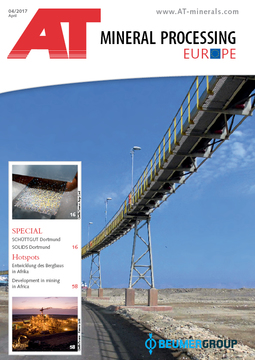Processing in inert gas
Single- or double-roller crushers are also used for coarse and intermediate crushing stages. Here, additional comminution aids like cam or tooth profiles affect the result. Starting from the grinding of abrasive products, double-roller mills are designed based on the size reduction ratio and required throughput rate. Generally smooth rollers are used to enable easy reworking of the rollers.
In the processing of metallurgical products, like different ferroalloys (FeSiCa, FeSiMg) or CaSi alloys, to avoid O2 contamination or explosion risks caused by H2 gases, appropriate precautions must be taken. For this purpose, the crushers are operated continuously in an inert gas atmosphere. The slight overpressure enables blanketing with nitrogen or argon. Design modifications of the equipment or machines used for the intermediate comminution of a feed size of around 30 mm to final particle size of around 5-8 mm are vital. The complete plant, especially comminution machines like the Merz WBP 8/8 roller mill with manual gap adjustment and hydraulic clamping of the grinding gap, is designed to be gas-tight to 400 mm head of water = 0.40 mbar (Fig. 2). The design of the seals between the shafts and the housing cannot be compared with simple dust-tight designs. The upper and lower sections of the housing are constructed from thick steel plates as flanged, machined structural components.
At normal temperatures, bellows seals with double grease chamber are used to ensure gas tightness to around 40 mbar (testing for 24 hours without any notable decrease). For hot materials or very sensitive products, an additional internal cooling of the rollers is recommended. For high-temperature operation, depending on the application, the shafts are sealed with elaborate graphite seals that must withstand possible deflagrations. With this configuration, sealing in the overpressure range can temporarily reach around 1 bar.
In addition, accumulation of large quantities dust should be avoided based on the selection of the correct angle of repose and suitable design of the transfer points and hoppers. Bins for intermediate storage of the products/intermediate products should be designed as small as possible or avoided in the process. Sacking and packaging of the products should also be performed in an inert gas atmosphere. The spent gas can be filtered and recycled, with compensation for any gas losses.
In the processing of ferroalloys, metallurgical silicon or CaSi alloys, sparks during the grinding with wear-resistant steel rollers cannot be excluded. To avoid dust explosions, O2 must be continuously monitored. The O2 concentration in the plant is measured and evaluated. If it exceeds set values, e.g. > 3.0 %, the O2 concentration is reduced with the blowing in of additional inert gas (N2) to avoid an explosion. For sizing comminuted CaSi alloys in particle sizes between 1 and 3 mm, the Merz screen (Fig. 3) is designed as gas-tight to enable nitrogen (N2) blanketing.
When coming into contact with residual water, CaSi alloys, especially those with a high content of slag, develop hazardous hydrogen (H2). The plants are designed with continuously operating H2 monitoring systems. At the uppermost point of the plant, the lighter H2 gas collects and is expelled by means of blowing in of additional N2 gas through a special valve. The equipment is designed with this necessity in mind.
In the first contact with the customer, the requirements for material and safety are openly discussed and a possible process is developed in cooperation with the customer. At the Merz Aufbereitungstechnik testing facility, in practical tests based on the process flow, volume flows are determined and the individual processing stages designed accordingly. With this practice-oriented approach, a process for processing ferroalloys or CaSi alloys is developed catering for any customer requirements.
//www.merz-aufbereitungstechnik.de" target="_blank" >www.merz-aufbereitungstechnik.de:www.merz-aufbereitungstechnik.de









